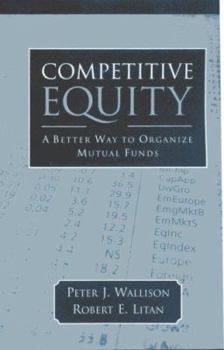Competitive Equity: Developing a Lower Cost Alternative to Mutual Funds
Mutual funds are a key resource for Americans saving for retirement, college, and other long-term goals. With hundreds of fund families and thousands of individual funds crowding the marketplace,... This description may be from another edition of this product.
Format:Paperback
Language:English
ISBN:084474252X
ISBN13:9780844742526
Release Date:April 2007
Publisher:AEI Press
Length:150 Pages
Weight:0.58 lbs.
Dimensions:0.5" x 6.1" x 9.0"
Customer Reviews
2 ratings
Competitive Equity is readily accessible to any reader
Published by Thriftbooks.com User , 17 years ago
Financial and economic experts Peter J. Wallison and Robert E. Litan present Competitive Equity: A Better Way to Organize Mutual Funds, a manifesto arguing that the current regulatory structure for mutual funds keeps costs for investors higher than they ought to be. Chapters cover the growth of the mutual fund industry and its competitors, the paradox of mutual fund fees, and the managed investment trust option. Though at times scholarly and technical in nature, Competitive Equity is readily accessible to any reader willing to apply the necessary concentration to understand complex financial matters. Notes and an index rounds out this thoughtful, well-reasoned product of the American Enterprise Institute for Public Policy Research.
Explains how competition and new forms of mutual investment can lower costs to investors
Published by Thriftbooks.com User , 17 years ago
Everyone is familiar with mutual funds and a great many people have some portion of their invested money in such programs. It is reported that something like $10 trillion is invested in mutual funds. Most people assume that they are safe, that they are efficient, and many even believe that they generally outperform the market. While there has not been a crisis with mutual funds, they generally do not outperform the market (it would be hard for all $10 trillion to be invested in the upper half of investments all the time), and there is a wide range of costs charged by the funds to the investors. This book shows that the most expensive can be three times as expensive as the least costly. Your returns are very much affected by the costs of the funds with which you invest your money. This book is quite interesting for those interested in looking at how current cost structures are set up in the mutual fund market, and some explanation of how they are regulated. The authors argue that these regulations actually do less to protect the investors than protect the advisors to these funds from price competition. Because of the way the current regulations are arranged, if the funds take risks to be aggressive and efficient on price, they risk actually earning less money, so they rarely do it. The authors propose a different type of mutual investment vehicle and call it a managed investment trust. The idea would be that the moneys would be held in trust by a bank and managed by outsiders who would then be motivated to be efficient and provide investment funds to customers at lower costs. While the book is really for those involved in the mutual fund and investment markets in a professional way or for very involved general investors, it is understandable by a motivated general reader.






